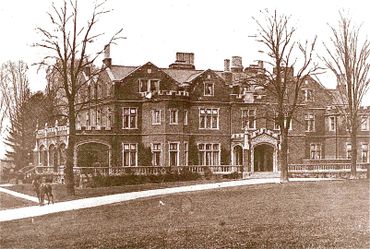STAATSBURG: A VILLAGE LOST IN TIME
The two-mile stretch of Old Post Road that spans the north and south access points from Route 9 and runs through the center of the Village of Staatsburg is today a peaceful, quaint thoroughfare. Some tourists still enter the village to visit Margaret Lewis Norrie State Park or the Staatsburgh State Historic Site, former home of the Mills family and now a museum. However, most vehicles traveling between the Town of Hyde Park to Staatsburg's south and the Town of Rhinebeck to its north rarely drive through village streets.
This quiet village stands in stark difference to the the Staatsburg that existed before 1932 when the Route 9 bypass was constructed east of the village. Before that, Old Post Road (formerly known as King's Highway and later Albany Post Road), was part of the main route between New York City and Albany. It boasted numerous lodging establishments, restaurants, gas stations, thriving businesses and nationally known industrial sites.
As part of the first stagecoach route, one of the oldest and still existing structures in the village served as a tavern and offered overnight accommodations to weary travelers. Larger hotels that operated under various owners' names lined the streets of the village and saw considerable business through the years.
Four elegant estates comprised much of the village land and were getaway properties for wealthy and successful businessmen and their families from New York City. In addition to the Mills clan, other village estates were owned by the Dinsmores and Hulls, and the Hoyts and Huntingtons. Two of those expansive properties still exist, one as a state park and the other privately owned.
When Hyde Park resident and U.S. President Franklin D. Roosevelt created the Civil Conservation Corps in 1933 as part of his New Deal program, Staatsburg housed Camp 1274. Its members built roads, stone bridges and a fine dining and dancing facility alongside the Hudson River, today's Margaret Lewis Norrie State Park. The camp was located just south of the park's main entrance.
Staatsburg once fielded a semi-pro baseball team, had three houses of worship and a flourishing New York Central Railroad station. Through the pages of this book, go back in time to a once bustling community and reflect upon buildings from an earlier era that served one purpose and have now been transformed to other uses. While many businesses closed after the bypass was built, in many ways the village that exists today is a preserved reflection of an earlier time in the region.
This is Staatsburg: A Village Lost in Time!

Photo Gallery














This website uses cookies.
We use cookies to analyze website traffic and optimize your website experience. By accepting our use of cookies, your data will be aggregated with all other user data.